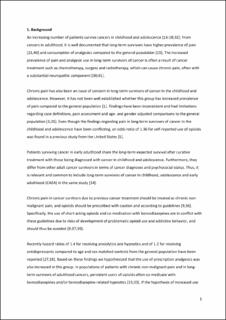Prescription of analgesics to long-term survivors of cancer in early adulthood, adolescence and childhood in Norway: a national cohort study
Fredheim, Olav Magnus; Skurtveit, Svetlana; Loge, Jon Håvard; Sjøgren, Per; Handal, Marte; Hjellvik, Vidar
Peer reviewed, Journal article
Accepted version
Permanent lenke
https://hdl.handle.net/11250/2731389Utgivelsesdato
2020Metadata
Vis full innførselSamlinger
Sammendrag
Increasing numbers survive cancers in childhood and adolescence. Long-term survivors of cancers in adulthood have increased prevalence of pain and consumption of analgesics. It is not established whether long-term survivors of cancers in childhood and adolescence also have an increased use of analgesics. However, based on increased use of antidepressants and anxiolytics in long-term survivors of cancers in childhood and adolescence, we hypothesized that this group also had increased use of analgesics. Based on data from the 2 nationwide registers, the Cancer Registry of Norway and the Norwegian Prescription Database, a cohort of 5585 (52% males) long-term survivors of cancers in childhood, adolescence, and early adult life was established. Age- and sex-adjusted comparisons were made to the general population. The age-adjusted one-year periodic prevalence of receiving prescriptions of opioids, benzodiazepines, and benzodiazepine-related hypnotics in the study population was increased by 20% to 50%, and the one-year periodic prevalence of receiving prescriptions of gabapentinoids was approximately increased 2-fold compared to the general population. For paracetamol and nonsteroidal anti-inflammatory drugs, no difference was found. For those survivors, who were persistent or high-dose users of opioids, comedication with high doses of benzodiazepines and/or benzodiazepine-related hypnotics was far more common than among persistent and high-dose opioid users in the general population. The high prevalence of gabapentinoids may indicate increased prevalence of neuropathic pain in this group. The high degree of comedication with benzodiazepines and/or benzodiazepine-related hypnotics in survivors on persistent and high-dose opioids might be an indication of problematic opioid use or addiction.
